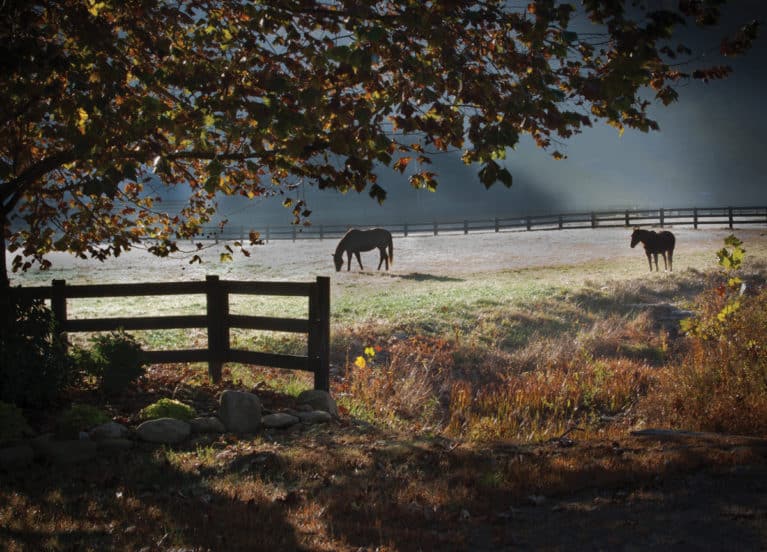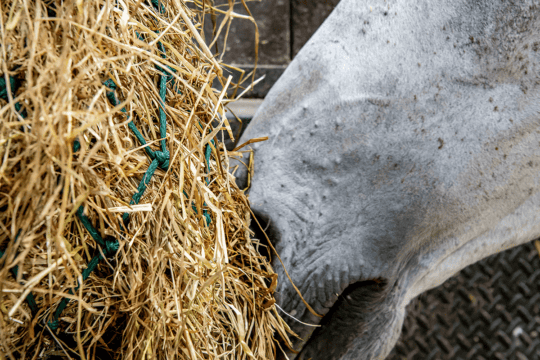Laminitis is usually associated with a flush of new spring grass, but mild, wet autumn weather can also spell trouble for your horse. Horse&Rider explains what you can do to minimise the risk

When we think of laminitis, the image that usually comes to mind is a chubby pony up to his knees in spring grass. However, this debilitating condition can affect horses and ponies of all shapes and sizes, and can strike at any time. Autumn sees a seasonal spike of cases. The warm days and cooler nights are ideal conditions for the grass to start growing again after going dormant over the hotter summer months – in a similar way to the flush of spring grass after the cold weather of winter.
What is laminitis?
Laminitis is the inflammation and weakening of the sensitive laminae that join your horse’s pedal bone to his hoof wall. This causes pain, because the hoof can’t swell to accommodate the inflammation. In some cases, laminitis can cause the pedal bone to detach from the hoof wall and rotate or sink towards your horse’s sole. There are two different types of laminitis…
- acute laminitis refers to the early stages of the disease, where there are clinical signs but the pedal bone hasn’t rotated or sunk. If treated promptly and effectively, acute cases can be prevented from developing into chronic cases.
- chronic laminitis is where the pedal bone has moved within the hoof. Affected horses may suffer ongoing problems, such as lameness or recurring abscesses, and long-term changes to the hoof structure.
If your horse has had laminitis once, he is more likely to get it again in the future, and his care and management could be lengthy, time-consuming and expensive. Therefore, prevention is paramount.
Causes of laminitis
Recent studies have shown that in the majority of cases, laminitis is a symptom of an underlying endocrine condition, such as equine metabolic syndrome (EMS) or pituitary pars intermedia dysfunction (PPID, formerly known as Cushing’s). Horses with these conditions have an abnormal reaction to non-structural carbohydrates (NSCs), which are found in grass. Unrestricted consumption of rich autumn grass not only provides your horse with a large quantity of calories, but the high levels of NSCs can cause an inflammatory response in the body, triggering laminitis. Excess body fat may also cause a hormonal imbalance, which can cause laminitis, so managing body weight is important – although laminitis doesn’t just affect fat horses, there’s a strong link between the two. It’s much easier to maintain your horse’s weight at a healthy level and prevent him putting more on, than putting him on a diet to try to lose it.
How to spot laminitis
The earlier a laminitis attack is caught, the greater the chance of recovery. Here are some of the things to look out for…
- signs of pain, such as reluctance to move, facial tension or a lack of interest in his surroundings
- excessive heat in his feet
- a strong or bounding digital pulse
- his front limbs placed in front of his body with his weight on his heels to relieve pain
- general stiffness
- alternate lifting of his feet and shifting of weight when standing
- a ‘pottery’ walk, with his heel set down before his toe
- lameness that is exaggerated by turning on a hard surface
If you spot any of these symptoms, call your vet immediately, as acute laminitis is considered an emergency. Do not move your horse unnecessarily, as this will cause him pain and further damage, although leaving him in the field may make the situation worse. Ideally, put your horse in his stable on a deep bed, with fresh water and hay. If you can’t move him out of the field, make him as comfortable as possible and restrict his access to grass.
Checking a digital pulse
To check your horse’s digital pulse, start at the middle of his pastern, at the back of his leg. Move your first two fingers towards the outside until you feel a bundle of vessels, where you should find his pulse. Alternatively, put your thumb and finger on either side of his pastern, just below the fetlock, and slide your hand down until you are just above his heel and can feel the pulse through your finger.
The pulse should always be detectable, as it means that your horse’s heart is pumping blood around this body, but if he’s healthy, it should be hard to feel, particularly if he is a heavier type or has feathers. Any abnormalities, including laminitis, will cause the pulse to become bounding and more easily felt.
TOP TIP
Testing your horse’s pulse regularly will help you work out what’s normal for him and mean any irregularities are easier to detect.
It’s time to act
As with so many conditions, prevention of laminitis is much better than trying to find a cure. Managing your horse’s weight and turnout isn’t always easy, but a few simple lifestyle changes can make all the difference to him this autumn. Act now to avoid being caught out when it’s too late.











